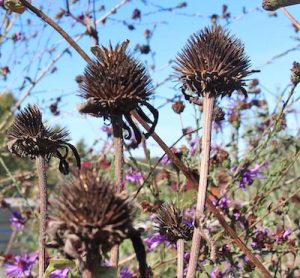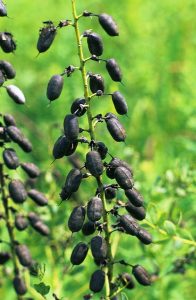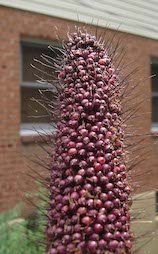Attractive Seedheads in the Fall and Winter Garden
By Pat Dickey, Fairfax Master Gardener

Blackberry lily seedhead
Fall is often the time when gardeners spruce up their flowerbeds by adding new mulch and deadheading annuals and perennials. But, in doing this, they are forgetting about the birds and other wildlife that continue to live in their gardens during the fall and winter months. They need a food supply, nesting materials for their winter beds and hiding places to protect themselves from predators. Why not wait to remove healthy seedheads as well as old flower stalks and leaves in the spring, and continue to enjoy their beauty this fall and winter? You can also bring a few seedheads inside for your own enjoyment while you take a much-needed break from your gardening chores.
Many native flowers, especially those from the Aster family (Asteraceae), have seedheads remaining in the fall and winter that are favorites for many birds, such as goldfinches, nuthatches, sparrows, chickadees, juncos and jays. Black-eyed Susans (Rudbeckia) and especially coneflowers (Echinacea) have magnificent dark dome-like seedheads that remain strong throughout the winter. They are especially beautiful after snow falls and as ice encrusts them. Tickseed (Coreopsis) also provides its dried flowers and seeds for many birds through the summer and into the winter months. Ironweed (Vernonia spp.), a favorite of butterflies and hummingbirds, stands erect with tooth-shaped leaves and small purple flowers gathered in loose bunches. Fluffy seeds fall later in the season and expose starry faux flowers in winter. Birds use the fluffy seeds for their winter nests.

Echinacea
There are also plants that offer beautiful seedheads you can use indoors during the fall and winter. Sea Holly or Rattlesnake-master Eryngium yuccifolium, a native plant from the Apiaceae or Carrot family, has tiny stemless flower clusters resembling thistles with sword-shaped bristly-edged leaves similar to yucca. Bees and butterflies love it, and you can also bring a few of its flowerheads indoors to give an added dimension to your flower arrangements. The same goes for Globe Thistle Echinops ritro, a member of the Aster family, that also attracts bees and butterflies and has showy, spiny spherical blue-purple flowerheads that persist throughout the winter. Blackberry lily (Iris domestica and formerly Belamcanda chinensis) has unusual pear-shaped seed capsules that fade from green to tan. They eventually open to show shiny black seeds in clusters, resembling large blackberries. The seeds remain on their stalks for several months and are striking when against a backdrop of snow. They can also be used indoors for striking additions to your arrangements.

Baptisia
Native plants with attractive seeded flower spikes can remain in the winter garden for wildlife, as well as for our own enjoyment. False blue indigo, Baptisia australis, a native plant from the Fabaceae or legume family, has purple lupine-like flowers on spikes that give way to seed pods. The pods turn charcoal black when ripe and are full of rattling seeds. Prairie Blazing Star Liatris pycnostachya, a native perennial of the Aster family, has upright stalks and fluffy purple flowers that can also be a food source for winter birds if they remain standing. Culver’s root Veronicastrum virginicum, is a wildflower also from the Fabaceae family. It grows up to 6 feet tall (2 m) with several spikes of dense, tiny white flowers, and its growth habit looks like a candlelabra. It is winter hardy, and birds forage for its seeds on the ground late into the season. Birds also love eating the seeds of native ornamental millet Pennisetum glaucum. It can remain in the garden longer than most annuals with its spikes of seeds. ‘Purple Majesty’ with its purple seed spikes is the most favored variety and original cultivar. Stalks are 4 to 5 feet tall (1.2 – 1.5 m) and also have showy, purple foliage. They can be used in dried arrangements as well.
Many annual flowers can also remain in the garden for an extended time with their seedheads for wildlife to enjoy. Zinnias, cosmos, sunflowers (Helianthus), marigolds (Tagetes) and bachelor buttons (Centaurea) are among them.

Millet
The native oak-leaf hydrangea, Hydrangea quercifolia has a showy inflorescence of greenish flowers that turn white then purplish and persist until mid-winter, and birds love to eat their seeds. Native maple trees (Acer) have winged pods or samaras, and Eastern redbuds (Cercis) have seed pods that persist into the fall, both a welcome find for the hungry wildlife. Cones filled with seeds from pines and spruces are also favorites of finches, chickadees, woodpeckers and nuthatches.
When the time change occurs in early November, we will lose one more hour of daylight. Days are becoming shorter and shorter as well. Fall and winter are challenging times because birds and other wildlife have less time to forage for food. By waiting to clean up our gardens in the spring, we will help to keep the wildlife there healthy and happy.
Resources
• Gardening with Native Plants: Winter Gardens, Susan Carpenter, Arboretum, University of
Wisconsin – Madison
• Should perennials be cut in the fall?, Emma Erler, University of New Hampshire Extension
• To Help Birds This Winter, Go Easy on the Yard Work, Andy McGlashen, National Audubon Society
• Plants for Feeding Birds, Marie Iannotti, The Spruce
• Winter Maintenance that Supports Pollinators and Birds, Bess Trout, Tyler Arboretum
• Birds that Eat Pine Cone Seeds, Sciencing
• Blackberry Lily, Susan Mahr, University of Wisconsin – Madison Extension
• Ornamental Millet, Pennisetum glacum, Susan Mahr, University of Wisconsin – Madison Extension